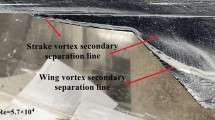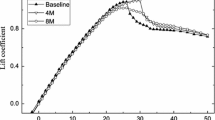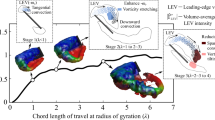Abstract
Instability, as a potential mechanism for vortex flow control, is manifested typically in the phenomenon of wingtip vortex wandering. In this paper, the evolution of wingtip vortex generated by a NACA0015 rectangular wing within six chord lengths of its wake at Rec= 2.1 × 105–3.5 × 105 and AoA = 4°–10° is investigated by stereo particle image velocimetry experiment. The streamwise evolution of vortex wandering is clearly captured, which demonstrates strong anisotropy. The amplitude of vortex wandering increases under all conditions, which exhibits greater growth rates in the condition of larger AoA. To account for such phenomenon, spatial linear stability analysis is performed on the base flow obtained by SPIV experiment to investigate quantitatively the amplification of small disturbance and disturbance modes at the experiment conditions. It is discovered that the wingtip vortex in the experiment is marginally stable under all conditions. Furthermore, the spatial growth rates of instability by AoA correspond well with that of wandering amplitude, indicating that the quick enlargement of the amplitude of wandering at larger AoA condition is caused by larger spatial growth rate of disturbance. In addition, the least-stable disturbance mode by LSA reveals a non-zero directed velocity perturbation in the vortex core, which rotates periodically. Such perturbation developing in both time and space, which is stirred by vortex instability, leads to the behavior of wingtip vortex wandering.









Similar content being viewed by others
References
Birch D, Lee T (2004) Structure and induced drag of a tip vortex[J]. J Aircr 41(5):1138–1145
Gerz T, Holzäpfel F, Darracq D (2002) Commercial aircraft wake vortices[J]. Prog Aerosp Sci 38(3):181–208
Leibovich S (1984) Vortex stability and breakdown—survey and extension[J]. AIAA J 22(9):1192–1206
Edstrand AM, Davis TB, Schmid PJ et al (2016) On the mechanism of trailing vortex wandering[J]. J Fluid Mech 806(R1):1–11
Bailey SCC, Tavoularis S (2008) Measurements of the velocity field of a wingtip vortex, wandering in grid turbulence[J]. J Fluid Mech 601(2008):281–315
Devenport WJ, Rife MC, Liapis SI et al (1996) The structure and development of a wing-tip vortex[J]. J Fluid Mech 312:67–106
Deem E, Edstrand A, Reger R et al (2013) Deconvolution correction for wandering in wingtip vortex flowfield data [J]. J Fluid Sci Technol 8(2):219–232
Beresh SJ, Henfling FJ, Spillers RW (2010) Meander of a fin trailing vortex and the origin of its turbulence[J]. Exp Fluids 49:599–611
Cheng Z, Qiu S, Xiang Y et al (2019) Quantitative features of wingtip vortex wandering based on the linear stability analysis[J]. AIAA J 57(7):2694–2709
Heyes AL, Jones RF, Smith DAR (2004) Wandering of wingtip vortices[C]. In: Proceedings of the 12th international symposium on application of lase techniques to fluid mechanics, vol 22, no 9, pp 1192–1206
Theofilis V (2003) Advances in global linear instability analysis of nonparallel and three-dimensional flows[J]. Prog Aerosp Sci 39:249–315
Mayer EW, Powell KG (1992) Viscous and inviscid instabilities of a trailing vortex[J]. J Fluid Mech 245:91–114
Fabre D, Jacquin L (2004) Viscous instabilities in trailing vortices at large swirl numbers[J]. J Fluid Mech 500(500):239–262
Oberleithner K, Sieber M, Nayeri CN et al (2011) Three-dimensional coherent structures in a swirling jet undergoing vortex breakdown: stability analysis and empirical mode construction[J]. J Fluid Mech 679:383–414
Edstrand AM, Schmid PJ, Taira K (2018) A parallel stability analysis of a trailing vortex wake[J]. J Fluid Mech 837:858–895
Edstrand AM, Sun Y, Schmid PJ et al (2018) Active attenuation of a trailing vortex inspired by a parabolized stability analysis[J]. J Fluid Mech 855(R2):1–12
Khorrami RM, Ash RL (1989) Application of spectral collocation techniques to the stability of swirling flows[J]. J Comput Phys 81:206–229
Parras L, Fernandes-Feria R (2006) Spatial stability and the onset of absolute instability of Batchelor’s vortex for high swirl numbers[J]. J Fluid Mech 583:27–43
Acknowledgements
Funding was provided by National Key Basic Research Program of China (Grant no. 2014CB744802), China Postdoctoral Science Foundation (Grant no. 2018M642007). Project supported by the major research project of the National Science Foundation of China (Grant No.91952302).
Author information
Authors and Affiliations
Corresponding author
Rights and permissions
About this article
Cite this article
Qiu, S., Xiang, Y. & Liu, H. The evolution of wingtip vortex wandering: a stability analysis based on stereo-PIV experiment. AS 3, 71–77 (2020). https://doi.org/10.1007/s42401-019-00040-y
Received:
Revised:
Accepted:
Published:
Issue Date:
DOI: https://doi.org/10.1007/s42401-019-00040-y




